HyunJoon Jung
Refer to Anything with Vision-Language Prompts
Jun 05, 2025Abstract:Recent image segmentation models have advanced to segment images into high-quality masks for visual entities, and yet they cannot provide comprehensive semantic understanding for complex queries based on both language and vision. This limitation reduces their effectiveness in applications that require user-friendly interactions driven by vision-language prompts. To bridge this gap, we introduce a novel task of omnimodal referring expression segmentation (ORES). In this task, a model produces a group of masks based on arbitrary prompts specified by text only or text plus reference visual entities. To address this new challenge, we propose a novel framework to "Refer to Any Segmentation Mask Group" (RAS), which augments segmentation models with complex multimodal interactions and comprehension via a mask-centric large multimodal model. For training and benchmarking ORES models, we create datasets MaskGroups-2M and MaskGroups-HQ to include diverse mask groups specified by text and reference entities. Through extensive evaluation, we demonstrate superior performance of RAS on our new ORES task, as well as classic referring expression segmentation (RES) and generalized referring expression segmentation (GRES) tasks. Project page: https://Ref2Any.github.io.
Text2Relight: Creative Portrait Relighting with Text Guidance
Dec 18, 2024



Abstract:We present a lighting-aware image editing pipeline that, given a portrait image and a text prompt, performs single image relighting. Our model modifies the lighting and color of both the foreground and background to align with the provided text description. The unbounded nature in creativeness of a text allows us to describe the lighting of a scene with any sensory features including temperature, emotion, smell, time, and so on. However, the modeling of such mapping between the unbounded text and lighting is extremely challenging due to the lack of dataset where there exists no scalable data that provides large pairs of text and relighting, and therefore, current text-driven image editing models does not generalize to lighting-specific use cases. We overcome this problem by introducing a novel data synthesis pipeline: First, diverse and creative text prompts that describe the scenes with various lighting are automatically generated under a crafted hierarchy using a large language model (*e.g.,* ChatGPT). A text-guided image generation model creates a lighting image that best matches the text. As a condition of the lighting images, we perform image-based relighting for both foreground and background using a single portrait image or a set of OLAT (One-Light-at-A-Time) images captured from lightstage system. Particularly for the background relighting, we represent the lighting image as a set of point lights and transfer them to other background images. A generative diffusion model learns the synthesized large-scale data with auxiliary task augmentation (*e.g.,* portrait delighting and light positioning) to correlate the latent text and lighting distribution for text-guided portrait relighting.
SwapAnything: Enabling Arbitrary Object Swapping in Personalized Visual Editing
Apr 08, 2024
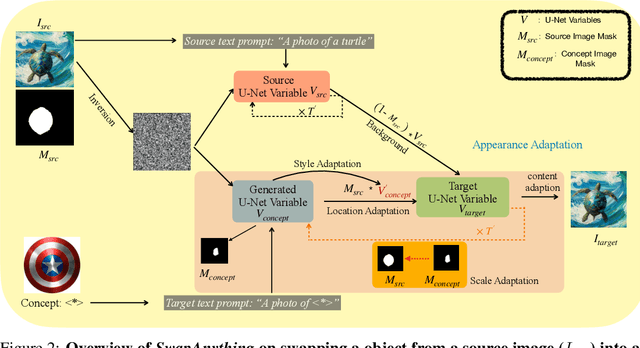
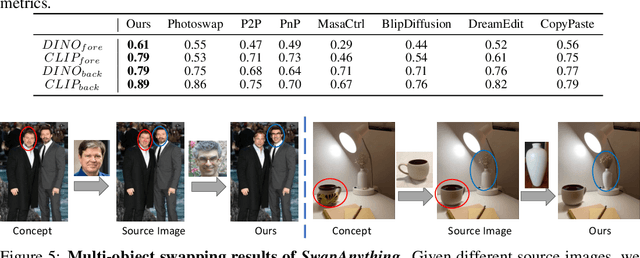

Abstract:Effective editing of personal content holds a pivotal role in enabling individuals to express their creativity, weaving captivating narratives within their visual stories, and elevate the overall quality and impact of their visual content. Therefore, in this work, we introduce SwapAnything, a novel framework that can swap any objects in an image with personalized concepts given by the reference, while keeping the context unchanged. Compared with existing methods for personalized subject swapping, SwapAnything has three unique advantages: (1) precise control of arbitrary objects and parts rather than the main subject, (2) more faithful preservation of context pixels, (3) better adaptation of the personalized concept to the image. First, we propose targeted variable swapping to apply region control over latent feature maps and swap masked variables for faithful context preservation and initial semantic concept swapping. Then, we introduce appearance adaptation, to seamlessly adapt the semantic concept into the original image in terms of target location, shape, style, and content during the image generation process. Extensive results on both human and automatic evaluation demonstrate significant improvements of our approach over baseline methods on personalized swapping. Furthermore, SwapAnything shows its precise and faithful swapping abilities across single object, multiple objects, partial object, and cross-domain swapping tasks. SwapAnything also achieves great performance on text-based swapping and tasks beyond swapping such as object insertion.
Holo-Relighting: Controllable Volumetric Portrait Relighting from a Single Image
Mar 14, 2024


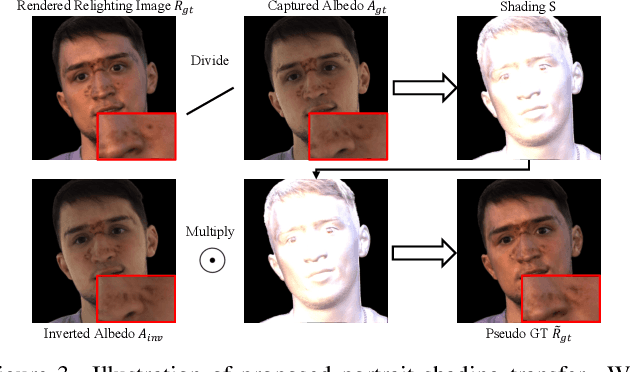
Abstract:At the core of portrait photography is the search for ideal lighting and viewpoint. The process often requires advanced knowledge in photography and an elaborate studio setup. In this work, we propose Holo-Relighting, a volumetric relighting method that is capable of synthesizing novel viewpoints, and novel lighting from a single image. Holo-Relighting leverages the pretrained 3D GAN (EG3D) to reconstruct geometry and appearance from an input portrait as a set of 3D-aware features. We design a relighting module conditioned on a given lighting to process these features, and predict a relit 3D representation in the form of a tri-plane, which can render to an arbitrary viewpoint through volume rendering. Besides viewpoint and lighting control, Holo-Relighting also takes the head pose as a condition to enable head-pose-dependent lighting effects. With these novel designs, Holo-Relighting can generate complex non-Lambertian lighting effects (e.g., specular highlights and cast shadows) without using any explicit physical lighting priors. We train Holo-Relighting with data captured with a light stage, and propose two data-rendering techniques to improve the data quality for training the volumetric relighting system. Through quantitative and qualitative experiments, we demonstrate Holo-Relighting can achieve state-of-the-arts relighting quality with better photorealism, 3D consistency and controllability.
Relightful Harmonization: Lighting-aware Portrait Background Replacement
Dec 11, 2023



Abstract:Portrait harmonization aims to composite a subject into a new background, adjusting its lighting and color to ensure harmony with the background scene. Existing harmonization techniques often only focus on adjusting the global color and brightness of the foreground and ignore crucial illumination cues from the background such as apparent lighting direction, leading to unrealistic compositions. We introduce Relightful Harmonization, a lighting-aware diffusion model designed to seamlessly harmonize sophisticated lighting effect for the foreground portrait using any background image. Our approach unfolds in three stages. First, we introduce a lighting representation module that allows our diffusion model to encode lighting information from target image background. Second, we introduce an alignment network that aligns lighting features learned from image background with lighting features learned from panorama environment maps, which is a complete representation for scene illumination. Last, to further boost the photorealism of the proposed method, we introduce a novel data simulation pipeline that generates synthetic training pairs from a diverse range of natural images, which are used to refine the model. Our method outperforms existing benchmarks in visual fidelity and lighting coherence, showing superior generalization in real-world testing scenarios, highlighting its versatility and practicality.
Photoswap: Personalized Subject Swapping in Images
May 29, 2023
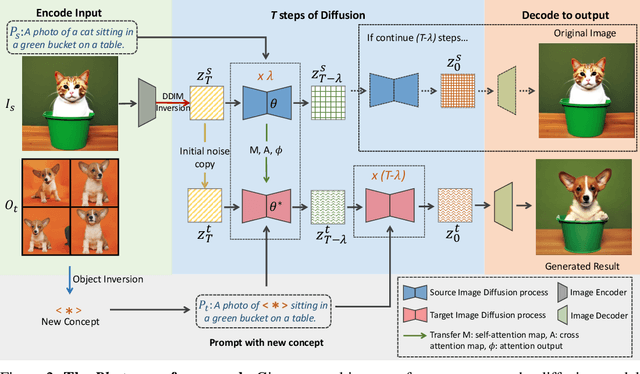
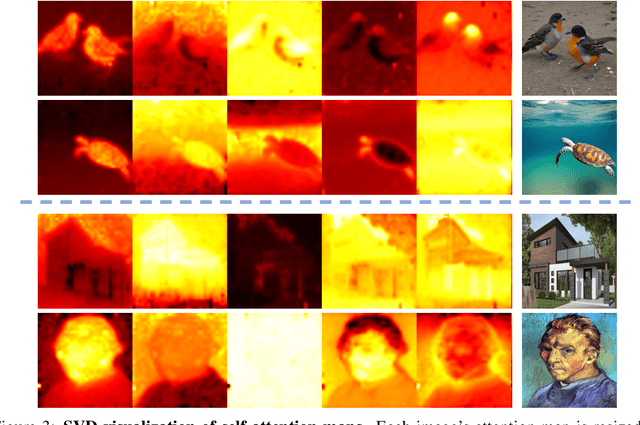
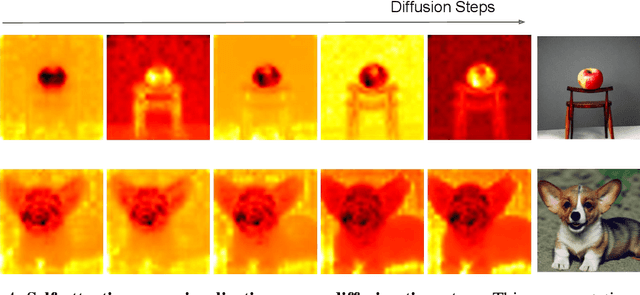
Abstract:In an era where images and visual content dominate our digital landscape, the ability to manipulate and personalize these images has become a necessity. Envision seamlessly substituting a tabby cat lounging on a sunlit window sill in a photograph with your own playful puppy, all while preserving the original charm and composition of the image. We present Photoswap, a novel approach that enables this immersive image editing experience through personalized subject swapping in existing images. Photoswap first learns the visual concept of the subject from reference images and then swaps it into the target image using pre-trained diffusion models in a training-free manner. We establish that a well-conceptualized visual subject can be seamlessly transferred to any image with appropriate self-attention and cross-attention manipulation, maintaining the pose of the swapped subject and the overall coherence of the image. Comprehensive experiments underscore the efficacy and controllability of Photoswap in personalized subject swapping. Furthermore, Photoswap significantly outperforms baseline methods in human ratings across subject swapping, background preservation, and overall quality, revealing its vast application potential, from entertainment to professional editing.
LightPainter: Interactive Portrait Relighting with Freehand Scribble
Mar 22, 2023Abstract:Recent portrait relighting methods have achieved realistic results of portrait lighting effects given a desired lighting representation such as an environment map. However, these methods are not intuitive for user interaction and lack precise lighting control. We introduce LightPainter, a scribble-based relighting system that allows users to interactively manipulate portrait lighting effect with ease. This is achieved by two conditional neural networks, a delighting module that recovers geometry and albedo optionally conditioned on skin tone, and a scribble-based module for relighting. To train the relighting module, we propose a novel scribble simulation procedure to mimic real user scribbles, which allows our pipeline to be trained without any human annotations. We demonstrate high-quality and flexible portrait lighting editing capability with both quantitative and qualitative experiments. User study comparisons with commercial lighting editing tools also demonstrate consistent user preference for our method.
 Add to Chrome
Add to Chrome Add to Firefox
Add to Firefox Add to Edge
Add to Edge